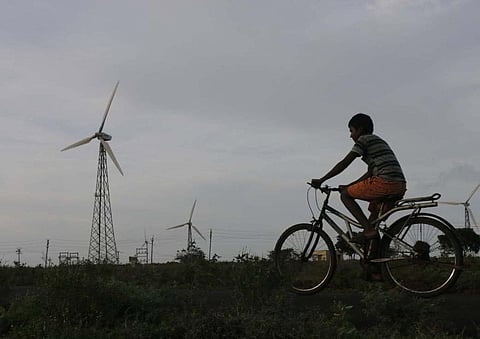

CHENNAI: In order to achieve zero carbon emission by 2030, there is an urgent need for the Tamil Nadu government to boost wind energy development after the state’s recent slip in rankings, say experts. Tamil Nadu had maintained a clear lead in the renewable power segment for about four decades.
However, as per the Indian Wind Turbine Manufacturers Association’s data accessed by TNIE, Gujarat tops the chart with a combined wind energy capacity of 11,018.92 MW as of July followed by Tamil Nadu with 10,198.020 MW. Gujarat was awarded by the Ministry of New & Renewable Energy recently for achieving the highest wind capacity addition during 2022-23.
S. Jeyakumaran, CEO of Vayulo Energy, a windmill producer based in Tirunelveli, explained, “One of Tamil Nadu’s main challenges is the availability of land. It takes five acres to set up one MW windmill. If the state utilises several parcels of government land in the southern districts for windmill installations, there is a better possibility to attract more investors”. Gujarat’s success lies in identifying suitable land for wind energy projects and utilising it effectively.
Jeyakumaran emphasised the need for Tamil Nadu to formulate a strategic policy for repowering old turbines. Meanwhile, the Gujarat government recently introduced the Renewable Energy Policy 2023.
“Changes in weather patterns and climate have led to a reduction in wind availability. Turbines older than 15-20 years with a capacity of 4-5 GW should be replaced in the state,” Jeyakumaran said.
R Sasikumar, another windpower producer in Tirunelveli, said, “Energy banking is an exchange of electricity for electricity. It is an arrangement where surplus power generated in a particular period is fed into the grid. This surplus energy known as banked energy is then supplied back during periods of low RE generation. With this arrangement, many wind energy producers benefitted till 2018.”
However, Tangedco discontinued the system, causing hardships to small companies and leading to the closure of several utilities, ultimately leading to the decline of wind energy projects in the state. A senior Tangedco official said, “The state government plans to establish windmills with a combined capacity of 5,000 MW across Tamil Nadu. Feasibility reports are being made. Once land identification is complete, further initiatives will commence.”The state government has to decide to reintroduce the banking system as it is a policy decision, he added.